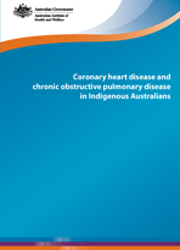Coronary heart disease and chronic obstructive pulmonary disease in Indigenous Australians
Citation
AIHW
Australian Institute of Health and Welfare (2014) Coronary heart disease and chronic obstructive pulmonary disease in Indigenous Australians, AIHW, Australian Government, accessed 27 April 2024.
APA
Australian Institute of Health and Welfare. (2014). Coronary heart disease and chronic obstructive pulmonary disease in Indigenous Australians. Canberra: AIHW.
MLA
Australian Institute of Health and Welfare. Coronary heart disease and chronic obstructive pulmonary disease in Indigenous Australians. AIHW, 2014.
Vancouver
Australian Institute of Health and Welfare. Coronary heart disease and chronic obstructive pulmonary disease in Indigenous Australians. Canberra: AIHW; 2014.
Harvard
Australian Institute of Health and Welfare 2014, Coronary heart disease and chronic obstructive pulmonary disease in Indigenous Australians, AIHW, Canberra.
PDF | 1Mb
The pattern of coronary heart disease and chronic obstructive pulmonary disease in Indigenous Australians differs to that in non-Indigenous Australians. This paper shows that Indigenous Australians have higher hospitalisation and death rates for these conditions than non-Indigenous Australians, and are more likely to die from these conditions at younger ages. However there are some encouraging trends seen in the Indigenous population, such as declining death rates from coronary heart disease, improved chronic disease management and declining smoking rates.
- ISBN: 978-1-74249-583-5
- Cat. no: IHW 126
- Pages: 56
-
Prevalence of CHD and COPD is high in the Indigenous population
-
Prevalence of several risk factors is high in both the Indigenous and non-Indigenous populations
-
Hospitalisation rate for CHD for Indigenous Australians was 2.4 times as high as the rate for non-Indigenous
-
Rate of Indigenous deaths due to CHD fell by 36% between 2001 and 2011



